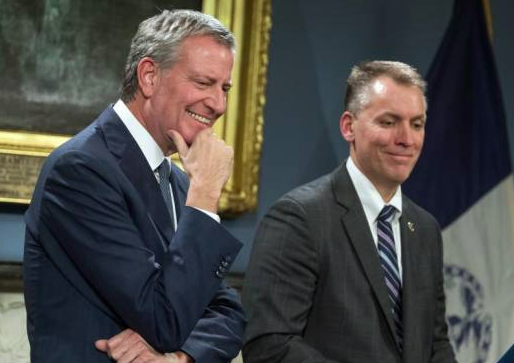City Council Speaker Corey Johnson and Mayor de Blasio promised to give the NYPD’s budget a $1 billion haircut as part of last week's budget vote. But the end result was barely a fingernail trim for the overfunded and entrenched department — frustrating advocates who had hoped for real police reform.
And no wonder. Mayor de Blasio has signaled time and again that he is four-square behind his police commissioner: “I'm very convinced that Commissioner Shea is going to keep moving an aggressive agenda of reform and help move the city forward,” he said recently. Translation: business as usual.
The truth is, few mayors want to contest the strength of the police unions or be accused of being soft on crime, and when it comes to the NYPD, de Blasio has never been bold enough to keep his own campaign promises. If the Council wants to get serious about fixing the NYPD, it must do something drastic: Take over the department itself.
The Council has the power to amend the City Charter, which stipulates the various city departments and how they are to be run. With a few hearings and votes, the Charter’s Section 431 could declare that it’s the Council, not the mayor, who hires and fires the police commissioner. That could change everything.
A Council-led amendment to the Charter is unusual, but hardly unprecedented. In 2008, the Council amended the Charter in order to create a one-time exception to term limits, allowing Mayor Bloomberg (and many sitting Council members) to run for another four-year gig. In doing so, it overrode the two separate city referenda that created term limits. If the Council could stomp on precedents to further the mayor’s and their own political careers, it can break another one to keep the NYPD from smothering the city with injustice.
Such an amendment would face high hurdles, including mayoral sabotage — even a possible veto. But for the sake of argument (this is a “modest proposal,” after all), let’s stipulate that it could happen.
How would a Council-controlled NYPD work? For starters, a Council-appointed commissioner would presumably cooperate with Council hearings and investigations, help discover the full depth of problems at the NYPD, and cooperate with Council members’ requests to prioritize fixes. With the current system, the police commissioner doesn’t even have to show up at Council hearings or provide useful answers when he does. Enabled by a mayor who never calls it to task, the NYPD have become experts at stymieing City Council’s intent.
Council members are much more aware of what is happening in their neighborhoods than the mayor ever could be; their newfound power to shake up the NYPD leadership and internal procedures would be informed (and, with hope, guided) by the feedback of their constituents.
Despite the mayor’s protestations that he has reformed the cops, the NYPD has pressed forward with what it has been doing for decades, namely targeting minorities for arrests, lying about how the police are beating up peaceful protesters, blaming traffic violence victims for their own deaths, framing innocent people, and more.
Like other police departments across the country, the NYPD has devolved into a dysfunctional institution that uses perverse incentives like summons quotas, arrest quotas and misclassification and discouragement of crime reports in order to provide (fake) evidence that crime is going down.
Almost every attempt at social reform in the city eventually runs into the stifling miasma of NYPD intransigence. The city sponsors youth and job programs in minority neighborhoods while the NYPD demoralizes those same communities with needless summons and arrests that ruin people’s lives. For years, the school system has served as a pipeline to prison because the NYPD-supervised school-safety agents enforced zero-tolerance policies that suspend or even arrest students for minor, non-criminal incidents.
The Vision Zero program to reduce traffic deaths has become a mockery in the NYPD's hands, used to justify ticketing cyclists after incidents in which cyclists were killed by errant motorists. The NYPD’s culture of insularity and antipathy to the public good (more than half of officers don’t even live in the city) needs to be changed, starting from the top down.
New Yorkers are clamoring for change. Every day of the week, large groups can be found marching (or biking) in the streets chanting "Black Lives Matter" and "Defund the NYPD." They’re calling for social justice, an end to white supremacy and — most urgently — for the reform of the NYPD.
It’s not likely the protests will make our mayor do anything sensible to change the status quo. But there’s still hope for the Council, where some vocal members want real change at the NYPD. If more members hear from their constituents that reform must happen now, maybe we will get action.
Ed Ravin (@VeloTraveler), a long-time bicycling and livable-streets advocate, is a past board member of the Five Borough Bicycle Club and Transportation Alternatives.







